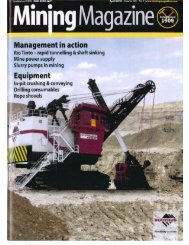clamp-on, sonar-based volumetric flow rate and gas ... - CiDRA
clamp-on, sonar-based volumetric flow rate and gas ... - CiDRA
clamp-on, sonar-based volumetric flow rate and gas ... - CiDRA
Create successful ePaper yourself
Turn your PDF publications into a flip-book with our unique Google optimized e-Paper software.
Flomeko 2005<br />
6 – 9 June 2005<br />
produced paper or worse still to a web break resulting in producti<strong>on</strong> loss. Entrained air in the<br />
paper <strong>and</strong> pulp industry is such a pervasive problem 4 that both mechanical <strong>and</strong> chemical<br />
means are used to remove air from the process. Likewise in producti<strong>on</strong> of crude oil, <strong>gas</strong> carry<br />
under in the liquid outlet of a twophase separator impairs the measurement of the <strong>rate</strong> of net<br />
oil <strong>flow</strong> as the watercut meter is affected by the presence of free <strong>gas</strong>. It is well known that the<br />
resulting errors in the net oil <strong>rate</strong> can easily be 100% or more solely because of a small error<br />
in the watercut.<br />
Just as often, however, process aerati<strong>on</strong> is an integral part of the producti<strong>on</strong> process <strong>and</strong> the<br />
air or <strong>gas</strong> c<strong>on</strong>tent must be kept within certain limits. By way of example, the injecti<strong>on</strong> of a<br />
small amount of air in the hydrotransport pipe lines in oil s<strong>and</strong> processing initiates the<br />
separati<strong>on</strong> of oil from s<strong>and</strong>. Likewise in the separati<strong>on</strong> of rock from minerals in flotati<strong>on</strong> cells,<br />
<strong>gas</strong> is sparged in at the bottom of the cell <strong>and</strong> the <strong>gas</strong> holdup in the cells must be c<strong>on</strong>trolled<br />
to optimize the gravity separati<strong>on</strong> of rock from mineral.<br />
The s<strong>on</strong>ar techniques that enable the interpretati<strong>on</strong> of the naturally occurring pressure fields<br />
inside a pipe are also well suited to determine the velocity of propagati<strong>on</strong> of acoustic pressure<br />
fields. The velocity of sound thus determined is a very sensitive indicator of process aerati<strong>on</strong><br />
<strong>and</strong> it offers a superior alternative to today’s mechanical, sample taking analyzers.<br />
The methodology involves characterizing the speed at which coherent pressure waves, either<br />
vortical structures or acoustic pressure fields, c<strong>on</strong>vect past an axial array of sensors using<br />
beam-forming techniques developed over several decades for underwater acoustic<br />
applicati<strong>on</strong>s. Since coherent vortical structures are an inherent feature of turbulent boundary<br />
layers, no internal geometry is required to gene<strong>rate</strong> these structures. Likewise, in the majority<br />
of industrial processes the proximity of pumps, compressors, valves or sharp bends ensures<br />
that no source of sound is required. The s<strong>on</strong>ar-<strong>based</strong> measurement is therefore entirely<br />
passive <strong>and</strong> it can be performed using an array of strain <strong>based</strong> sensors mounted <strong>on</strong> the<br />
outside of the pipe. With no process-wetted hardware, the s<strong>on</strong>ar <strong>flow</strong> measurement<br />
technology is well suited for the corrosive <strong>and</strong> abrasive slurries comm<strong>on</strong>ly encountered in<br />
many practical applicati<strong>on</strong>s.<br />
3 FLOW RATE MEASUREMENT<br />
The overwhelming majority of industrial process <strong>flow</strong>s involve turbulent <strong>flow</strong>. Turbulent<br />
fluctuati<strong>on</strong>s within the process <strong>flow</strong> govern many of the <strong>flow</strong> properties of practical interest<br />
including the pressure drop, heat transfer <strong>and</strong> mixing. For these reas<strong>on</strong>s, turbulent pipe <strong>flow</strong>s<br />
have been extensively studied over the years with roots back to Osbourne Reynolds <strong>and</strong> Lord<br />
Rayleigh in the late nineteenth century 5 .<br />
3.1 Turbulent pipe <strong>flow</strong><br />
For engineering applicati<strong>on</strong>s, c<strong>on</strong>sidering <strong>on</strong>ly the time averaged properties of turbulent <strong>flow</strong>s<br />
is often sufficient for design purposes. For s<strong>on</strong>ar <strong>flow</strong> metering technology, underst<strong>and</strong>ing the<br />
time averaged velocity profile in turbulent <strong>flow</strong> provides a means to interpret the relati<strong>on</strong>ship<br />
between speed at which coherent structures c<strong>on</strong>vect <strong>and</strong> the <strong>volumetric</strong>ally averaged <strong>flow</strong><br />
<strong>rate</strong> within a pipe. For turbulent<br />
<strong>flow</strong>s, the time-averaged axial<br />
velocity varies with radial positi<strong>on</strong>,<br />
from zero the wall to a maximum at<br />
the centerline of the pipe. The <strong>flow</strong><br />
near the wall is characterized by<br />
steep velocity gradients <strong>and</strong><br />
Figure 1: Coherent structures in turbulent pipe <strong>flow</strong>s.<br />
transiti<strong>on</strong>s to relatively uniform core<br />
<strong>flow</strong> near the center of the pipe.<br />
Figure 1 shows a representative<br />
schematic of a velocity profile <strong>and</strong><br />
coherent vortical <strong>flow</strong> structures<br />
present in fully developed turbulent<br />
pipe <strong>flow</strong>.<br />
BI0197 RevB 2



